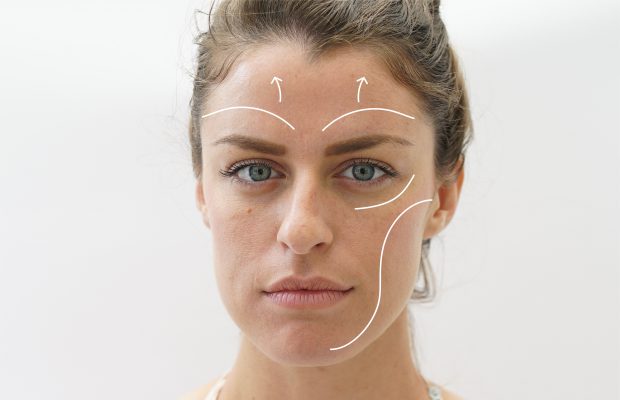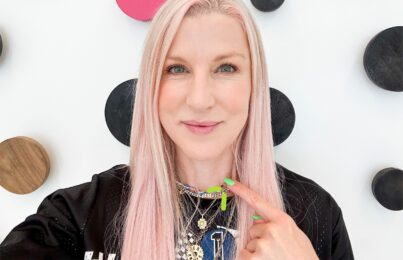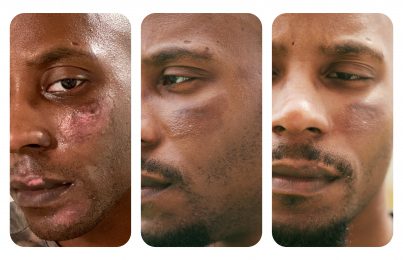As a professional esthetician, I know firsthand the power of a good skincare routine. Skin quality is a huge component of aging— it includes elements like brightness, evenness of tone, and hydration. In this golden age of skin care, we have the ability to preserve these elements better than ever before.
While skin care can take us a long way, there are certain components of aging it will just never be able to address. This is where cosmetic procedures come into play. If you’re just getting started, there are of course many non-invasive (or minimally-invasive) procedures, including injectables. These smaller procedures have gained a lot of traction in the past decade, but one old faithful is making a comeback: the facelift. Advanced techniques and a more nuanced approach have rekindled interest, and facelifts are on the rise. Notably, they’re being sought out by younger demographics than ever before.
There’s a lot that goes into making a decision as big as whether or not to get a facelift, and it’s ultimately a deeply personal choice. If you’ve been considering it (or are just curious), this post will help you get started. To learn more about the advanced techniques used in modern facelifting, I tapped into Dr. Sam Lam—an experienced, board-certified facial plastic surgeon with his own practice located in Plano, Texas.
What Does a Facelift Entail, and How Have Facelifts Changed?
Dr. Lam is the first to note that the term “facelift” can be somewhat confusing, especially since it may imply different things to different people. “The easiest way to divide the face is into thirds,” he says. “Upper, middle and lower, where the lower third encompasses both the jawline (jowls) and the neck. Lifting the upper third is really what’s now known as a brow lift. Today, advanced facelifting lifts the mid-face, lower face, and neck area as a single, composite unit. So as a surgeon, when I use the term facelift, I’m talking about these areas.”
To understand how a facelift works, it helps to know how they’ve changed over the years. As Dr. Lam mentioned, the face can be divided into thirds; these areas can be lifted individually if a patient desires. For example, a mid-face lift involves lifting only the cheek area, whereas a “mini” facelift refers to lifting exclusively the lower third of the face. Another very key advancement has been the depth of the treatment. Originally, the face was treated as one whole unit, and the skin was cut then stretched taught. Because none of the underlying structures of the face were addressed during this procedure, surgeons often stretched the skin in an exaggerated way to compensate and make the facelift last longer (needless to say, this didn’t yield the most natural-looking result).
Different Types of Facelifts
Now, surgeons are going deeper. A standard facelift is known as SMAS (superficial musculoaponeurotic system), and it involves tightening the connective tissue surrounding the muscles. Dr. Lam favors an even deeper type of facelift, known as a deep-plane facelift. This involves tightening the underside of the muscles themselves.
“Both a SMAS facelift and a deep-plane facelift involve lifting the same plane of tissue known as the SMAS, which is a confluence of muscle, fascia, and collagen,” says Dr. Lam. “It has great tensile strength for lifting. The difference is that with the deep-plane lift, the surgeon releases certain ligaments that reside below the SMAS layer so that the lift glides effortlessly and holds upward in position.” He noted that this also allows results to last longer.
Which Aspects of Aging Can a Facelift Address?
According to Dr. Lam, aging can be divided into three main categories: skin quality, volume loss, and sagging. A facelift is designed to address sagging, and it’s the only way to reverse skin laxity in a meaningful way. While we can influence skin quality by being good about our skincare routines, volume loss and sagging can’t really be addressed topically. Instead, intervention in the form of cosmetic procedures is usually required. This is because both volume loss and sagging are caused by changes to the underlying muscle, fat, and bone in our faces that occur as we age.
Addressing Volume Loss
When it comes to volume loss, Dr. Lam says it’s the upper face that requires the most attention. Hollowing tends to be most prominent in the temples and outer face, as well as around the eyes. “I find that the upper face really needs more volume than lifting,” says Dr. Lam, adding that he’s not always a fan of how browlifts look. “An easy way to think about it is that the upper half of the face requires more volume, and the lower face requires using some kind of lifting.”
Volume loss can, of course, be addressed using fillers (however Dr. Lam says the idea that fillers help prevent sagging is a misconception). Another method of volume replacement that’s becoming increasingly popular is fat transfer. Fat is taken from another area of the patient’s body and judiciously placed in the face to plump out sunken areas and return volume. Fat transfers are often performed in conjunction with a facelift.
Addressing Sagging
Once sagging starts to occur, you’re getting into facelift territory. “Signs of sagging in the jawline would be usually the earliest sign of aging that would benefit from a facelift,” says Dr. Lam. “Usually, neck descent and neck banding (vertical lines that protrude) are moderately later signs, but can also be the first sign.”
Now, there are ways to delay the onset of sagging. Using active skincare ingredients that encourage elasticity is one way. Practicing healthy lifestyle habits such as eating healthy, not smoking, and avoiding excessive sun exposure is another. Certain treatments like microcurrent (which can also be done at home) can help by toning and slightly lifting underlying muscles. Sagging is a natural (and normal!) part of aging though, and once it occurs, a facelift is the only proven way to truly reverse it. Of course, whether or not you want to pursue one is a personal choice, but I still think this is important to know because it helps people avoid fraudulent marketing claims. If a company is making promises about a skin-tightening product or device that seem too good to be true, it’s a red flag.
What’s the Best Age to Get a Facelift?
I hear this question a lot, and there truly is no one-size-fits-all answer. You’ve heard me say time and again that everyone’s skin is unique, and this means everyone will age differently. Again, lifestyle factors come into play, but genetics also play a role. (Speaking of which, these three facial features can keep you looking younger.)
Dr. Lam says his facelift patients are typically in their 50s or early 60s, but he confirmed that there’s a growing trend of those in their 40s seeking out facelifts. “It is now much more common for me to perform ‘early’ facelifts in 40-somethings who are wanting a rejuvenation with some noticeable changes that filler and Botox cannot deliver,” he says. An earlier facelift can be appealing because it requires less upkeep and maintenance than injectables while also delivering a more dramatic result. Injectables can still be used as a supportive treatment, but they can be used more sparingly in conjunction with a facelift.
There’s also the school of thought that getting a facelift in your 40s allows for a more natural and discreet result, possibly with less downtime. This is because there’s less lax skin to be cut away, and the face and neck muscles are still fairly robust. In theory, this allows for a more predictable result. That said, while the effects of a facelift are essentially permanent, a facelift won’t stop the aging process. Many patients will seek out additional tightening procedures 10-15 years down the line as signs of sagging start to appear again (though there won’t be as much skin to cut away as there would have been without the initial procedure). Either way, this is something to take into consideration and discuss with your surgeon when deciding how early to start. Always be sure to ask them about the long-term game plan and how a procedure fits into that plan.
What is the Healing Process Like?
Advanced techniques and gentle surgeons mean healing is less taxing than it used to be. But make no mistake, a facelift is still major surgery and a big undertaking. It’s not something that should be taken lightly.
“Most distorting swelling is present for the first seven to ten days,” says Dr. Lam, adding that swelling can be mitigated through gentle surgical techniques. “I am a very gentle surgeon, and that makes all the difference. This makes my recoveries easier, with very little discomfort. In the right candidate, I also use a medicine called tranexamic acid. This can virtually eliminate bruising in my patients, and it helps with the recovery process a lot.”
While the worst of the swelling may start to go down after the first two weeks, I always advise my clients not to get a facelift against any sort of timeline. If you want to be ready for a specific event, I would ideally suggest getting the procedure a year out. Swelling can be unpredictable, as I witnessed when I owned my spa up in Dallas—a prominent plastic surgeon in town used to send me his post-op patients for lymphatic drainage massage when they were having trouble with swelling. While better, gentler techniques mean you’ll be ready to return to the public eye much sooner than before, any surgery can have unpredictable side effects. Give yourself plenty of time for the final result to settle!
What About Scars?
Much like the rest of the facelift process, scars have become fairly finetuned. Scars should be camouflaged inside the hairline and along the fronts of the ears, with Dr. Lam adding that he doesn’t make straight incisions along the ear because this makes them harder for the eye to follow. “Along hairlines, I perform a procedure known as a trichophytic incision,” he says. “I intentionally transect or cut a row of hairs so that the hairs grow through the scar, making the scar very hard to see. I have close-up videos of my incision on my website, and I would be surprised if you can even find them.”
All in all, with a good surgeon who takes the correct approach, scars should start to fade within six months. The final color of your scar can vary based on skin tone, so this is definitely something to discuss with your surgeon during consultation.
Read more about how to prevent and minimize facial scarring.
Questions to Ask Yourself Before Considering a Facelift
It goes without saying that undertaking something as serious as a facelift is a choice you should make for yourself, and no one else. It’s a big decision! To make sure a facelift is really the solution they’re looking for, I encourage people to ask themselves a few questions.
1. Why am I doing it?
Deciding to get a facelift isn’t just about logistics, it’s also about emotions. Many plastic surgeons will take into account a patient’s state of mind before performing such an invasive procedure. I always advise people to step back and make sure they aren’t trying to fix other areas of their life by addressing their appearance. Some people are also shocked by how they look directly after surgery because of all the distortion, so it’s important to mentally prepare and talk with your surgeon about what to expect. That said, if it really is about boosting confidence by reclaiming certain aspects of your appearance, a facelift can definitely be the right decision.
2. Are there other aspects of my appearance I’d rather switch up instead?
Sometimes I find that people start considering a facelift when they’re in a rut, simply because they don’t know where else to start. If this is the case, I encourage you to try switching up other aspects of your appearance first in order to boost your mood and confidence. Trust me, it can make more of a difference than you think!
3. Does this surgeon fit my desired aesthetic?
Facelifts used to be much more one-size-fits-all. Now, there’s a lot more tailoring and variation involved, so it’s more important than ever that you find a surgeon whose vision aligns with yours. Be diligent about doing your research—get referrals, review before and afters, and ask lots of questions during your consultation.
Up next, read my beginner’s guide to healthy skin aging.
Celebrity Esthetician & Skincare Expert
As an esthetician trained in cosmetic chemistry, Renée Rouleau has spent 30 years researching skin, educating her audience, and building an award-winning line of products. Her hands-on experience as an esthetician and trusted skin care expert has created a real-world solution — products that are formulated for nine different types of skin so your face will get exactly what it needs to look and feel its best. Trusted by celebrities, editors, bloggers, and skincare obsessives around the globe, her vast real-world knowledge and constant research are why Marie Claire calls her “the most passionate skin practitioner we know.”



